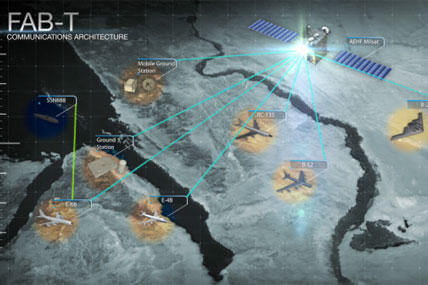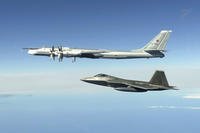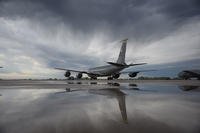Raytheon Co. is challenging Boeing Co. on a potential $4.7 billion U.S. military program to develop satellite communications devices to ensure the president can talk to commanders after a nuclear attack.
The companies are vying to build so-called Family of Advanced Beyond-Line-of-Site Terminals, known in military parlance as FAB-T. Outfitted in ground stations and aircraft such as the bat-winged B-2 bomber, the terminals can relay secure communications at higher bandwidth using a network of military satellites.
The Air Force last year invited Raytheon to compete after becoming concerned that Boeing, which began developing the devices more than a decade ago, would have to further delay the schedule because of design changes.
"We know we're in a fight here and want to go off and win," Scott Whatmough, Raytheon's vice president of integrated communications systems, said in a telephone interview. "It's going to come down to affordability and capability."
Using a modem and other technology the company previously developed for the Army and Navy, the Raytheon system passed a critical design review in June and is on pace to connect to a satellite as part of a test in October – a much faster timeline than the two years typically needed to achieve such milestones, Whatmough said.
Boeing, meanwhile, has incorporated the design changes requested by the Air Force, including adding a feature called Presidential and National Voice Conferencing, which will allow the president, defense secretary, chairman of the Joint Chiefs of Staff and other senior leaders to talk from anywhere in the world using FAB-T terminals and Advanced Extremely High Frequency, or AEHF, satellites.
"We have spent the last year and a half knocking down all the concerns that the Air force had with the risk to the program," Paul Geery, a Boeing vice president who manages the FAB-T program, said in a telephone interview. "We've completed our development work and flown on aircraft.
"Now it's just a question of price," he added. "Budgets are going to drive a lot of decision-making."
The Defense Department over the next decade faces $500 billion in automatic budget cuts known as sequestration. That's in addition to almost $500 billion in defense reductions already included in 2011 deficit-reduction legislation. The first installment of the automatic cuts began March 1 after lawmakers were unable to reach an alternative agreement on taxes and spending.
The across-the-board reductions threaten every aspect of the defense budget, from weapons and equipment to the size of the armed forces.
The Air Force's decision to open the FAB-T program to competition was designed in part to control costs and ensure the delivery of presidential conference system in 2015, according to the Pentagon. The service also last year changed its agreement with Boeing to a fixed-price contract, which puts more of the risk on the contractor, from a cost-plus contract, in which the contractor is paid for allowed expenses.
The effort is nowhere near the cost of the F-35 Joint Strike Fighter – the Pentagon's most expensive weapons program at $391 billion. Nevertheless, it has had cost increases and schedule delays, according to a March report from the Government Accountability Office, the investigative arm of Congress.
The FAB-T program was once estimated to be as many as 16 months behind schedule, creating as much as $240 million in added expenses, according to a Pentagon acquisition report prepared at the end of 2011 and released the following year. The latest version of the report hasn't been made public.
Overall, the program is now projected to cost $4.67 billion, a 48-percent increase from the original estimate of $3.17 billion, according to Pentagon acquisition figures released in May. Almost half of that amount has been spent.
The latest estimate assumes buying a total of 246 devices to upgrade existing command post terminals located on the ground and in E-4B and E-6 aircraft, and to install in B-2 and B-52 bombers and RC-135 reconnaissance aircraft.
The Air Force, however, is considering scrapping its plans to outfit the bomber fleets with the terminals. Under such a move, the GAO warned, "FAB-T may not meet its full range of planned communications capabilities as some are based on the interaction of bomber aircraft with intelligence, surveillance, and reconnaissance aircraft and command terminals."
An Air Force spokeswoman didn't immediately respond to a Military.com request for comment from Col. Cordell DeLaPena, who manages the program at Hanscom Air Force Base, Mass.
The Air Force plans to award both Boeing and Raytheon manufacturing readiness contracts this summer. The bigger announcement will come at the end of the year or early next year, when the service selects one of the two companies for initial production work.





























